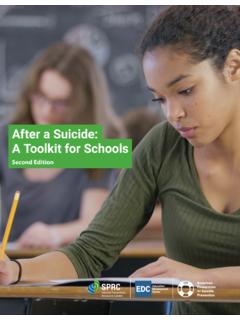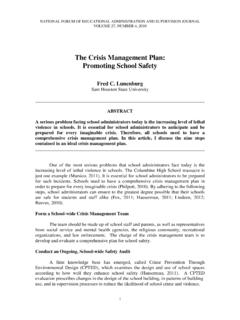Transcription of A resource for mental health professionals
1 A resource for mental health professionalsContentsRecovery and the mental health system ..4 What is recovery? ..5 Is recovery the way forward? ..6 suicide prevention in the mental health sector ..8 Assessing suicide risk ..10 Working with suicidal people ..11 Addressing suicide in a recovery-oriented manner ..12 1 Build a positive working relationship with the consumer ..14 2 Consider risk assessment holistically ..15 3 Work collaboratively with family and friends ..16 4 Support the consumer s independence and decision making ..17 5 Support the consumer in times of transition ..18 6 Promote recovery, build resilience ..19 7 Communicate respectfully ..20 8 Provide support after suicide ..21 9 Stay healthy yourself ..22 10 Enrol in additional suicide prevention training ..24 Conclusion ..26 Continued professional Development ..28 Acknowledgements ..28 References ..30 suicide prevention and Recovery guide A resource for mental health professionals3 This guide is unique because it examines suicide prevention through the lens of recovery.
2 This is particularly relevant as the management of suicide risk, especially when it leads to involuntary hospitalisation, may be perceived at times to conflict with recovery principles encouraging services to support consumer choice and decision-making. The guide helps workers to reflect on how they address suicide in their workplace, and in what ways they can support the individual s recovery during this time. An important part of recovery-focused suicide prevention is to talk to clients when they are well, about what they would like to happen when they are not. How mental health professionals can instil a sense of hope and encourage individual responsibility, while still upholding their duty of care for consumer and community safety, is central to this guide is suitable for mental health professionals including mental health support workers, peer workers, mental health nurses, psychologists, psychiatrists, social workers, general practitioners and occupational therapists working in both community and hospital settings.
3 Although workers in different settings may focus on different aspects of care, recognising and responding to people experiencing suicidal thoughts and behaviours is relevant to all. It is just as important that those working in a community setting are confident to address the issue of suicide as it is for clinicians to think of suicide in terms broader than pathology and treatment of an majority of mental health professionals work hard with their clients to improve mental health and reduce the likelihood of suicide . This guide is intended to be a broad overview of how suicide can be approached from a recovery perspective to help them continue their essential work. It is not a how to book on preventing suicide , but it is intended to provide a useful resource , encouraging a holistic and inclusive view that puts the consumer at the centre of guide has undergone a review process by a range of mental health professionals across different service settings as well as consumers and carers.
4 For a full methodological outline please contact SANE suicide prevention and Recovery guide encourages mental health professionals to work on: fBuilding a positive working relationship with the consumer fConsidering risk assessment in a way that fully engages with the consumer fWorking collaboratively with family and friends fSupporting the consumer s independence and decision-making fSupporting the consumer in times of transition between services and discharge fPromoting recovery and building resilience fCommunicating respectfully when talking about suicide and mental illness fHow to provide support to families and friends after suicide fStaying healthy themselves by engaging in self-care and distress tolerance fContinued professional development and training in suicide SANE Australia suicide prevention and Recovery guide aims to help mental health professionals support people who are experiencing suicidal thoughts and behaviours through the prevention of suicide , and in crisis and the mental health systemWhat is recovery?
5 Recovery in mental health is a concept that stemmed from deinstitutionalisation and the physical disability movement in America in the 1980s and 1990s. The idea of recovery was conceptualised by people who had first-hand experience of mental illness, yet achieved fulfilling lives despite being told that their situation would never improve. At its core, a recovery approach encourages people to take control of their lives and nurtures hope that they can achieve their goals despite the presence of mental The recovery approach has been promoted both in Australia and internationally as a key component to a fair and progressive mental health system, but a challenge with the concept is that it means something different to the traditional definition of recovery that is, relating to a cure from an illness. Rather, recovery from mental illness is a process by which people regain hope and move forward with their lives with or without the symptoms of mental illness.
6 Whether one is recovered is highly it is recognised that recovery is a unique personal journey, the literature identifies a number of common factors that facilitate recovery. These have been summarised by the NSW mental health Coordinating Council 3 as: individual responsibility, acceptance, hope, identity, empowerment, and advocacy. Many people writing about recovery emphasise hope as perhaps the single most important of these factors. For example:Many recovery stories describe the devastating effects of having been told by mental health professionals that prospects for recovery were slim or non-existent .. those who feel they have recovered generally find ways to maintain, regain or create hope that somehow, someday, things will be better. 4 (p. 246) The National mental health Commission s first Report Card 34 (2012) recognised the importance of the recovery perspective; its very first recommendation was that people with a mental illness be at the centre of decision-making about all services that affect NSW mental health Coordinating Council in partnership with the NSW Consumer Advisory Group has developed a comprehensive resource for services: the Recovery Oriented Service Self-Assessment Tool (ROSSAT).
7 5 Resources such as these are useful in helping services think about recovery and its application, but often do not explicitly talk about the management of suicide . If services are to embrace recovery across all dimensions of service delivery, the concept must be examined in light of one of the most challenging aspects of care suicide prevention . suicide prevention and Recovery guide : A resource for mental health professionals6Is recovery the way forward?Although recovery is widely promoted within the Australian mental health sector, and indeed forms the core of many State Government mental health reforms currently under way,6 the model has been criticised for putting additional pressure on services, building false expectations for consumers and their families, and failing to address the issue of risk. 7, 8 These are important issues to consider when thinking about how services can operate within this may feel pressure from many competing areas that make being fully engaged with recovery seemingly difficult.
8 For example, the emphasis on the reduction of bed stays within in-patient units, the lack of time staff have to build effective working relationships, the emphasis on reporting against clinical outcomes as opposed to recovery-based outcomes, and the problems with objectively measuring recovery 9 are all potential obstacles. However, advocates argue that recovery is a process in which a person with mental illness works to figure out how to manage and live with their symptoms of mental ill health and:It is not a fad, an added burden, or a new and as yet unproved practice imposed on already stretched providers. As such it is neither something services can do for people with mental illness, nor is it something that can be promoted as separate from treatment and other clinical services. Recovery should be the ultimate goal of mental health services and this should not be conceptualised as an add-on to already existing services 10 (p.)
9 643)It is argued by some that promoting recovery is giving false hope to consumers and their families, particularly if they believe recovery equates with being free from mental illness. However, supporters of the recovery paradigm argue that for a long time consumers and their families have been given a false sense of hopelessness, and that the focus needs to shift to a much more positive Further, it is argued that recovery aims to set up realistic expectations about what a person can achieve. It focuses on building a person s strengths and supports, and making the consumer the expert in their own experience. This is a big shift from previous ways of operating where clinical experts worked to bring about compliance to treatment, often with little regard to the consumer s perspective and in many cases leading to disempowerment and dependence on the mental health system. Another commonly expressed concern about recovery involves questions of ethics and risk.
10 mental health professionals may ask how recovery can be relevant to someone experiencing an acute episode of psychosis or mania, as surely a person in that situation would need to get better before recovery can be discussed. Similarly, staff may question the focus on strengths, hopes and dreams when a person is faced with urgent needs such as safety, shelter and stabilisation. What sense does it make to honour the choices of someone who is acutely unwell, potentially leaving them to reject treatment and risk self-harm?22 (p. 643) (p. 643) suicide prevention and Recovery guide : A resource for mental health professionals7 Davidson et al argue that if a person is experiencing a crisis, recovery doesn t start after the episode resolves, and it cannot be put on hold while the person receives treatment. From the person s perspective, the crisis has temporarily disrupted the ongoing process of recovery, and care during this time can support or undermine that process.








